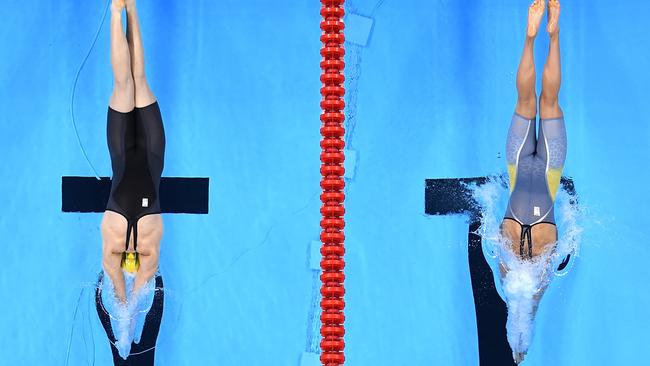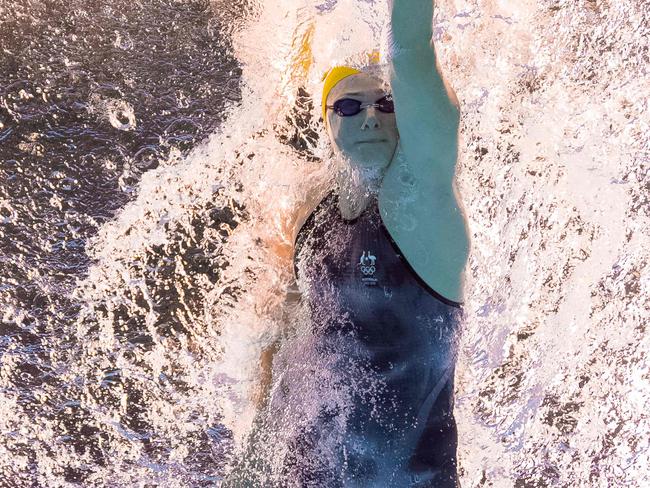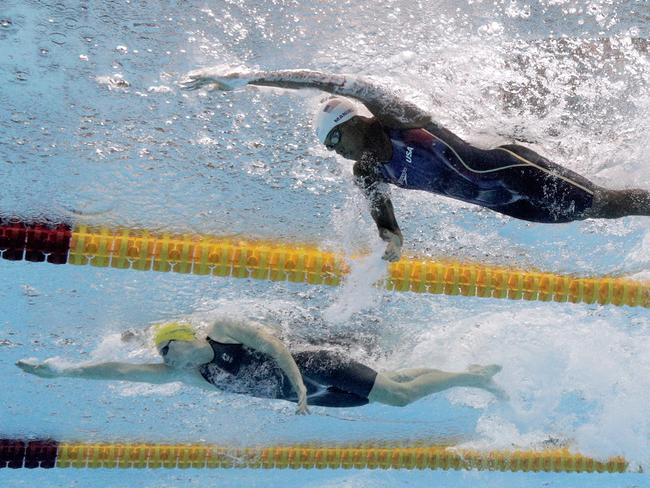Did a pool blunder screw swimmers?
SURE, the Olympic swimming pool didn’t turn green, but may have fallen victim to a far more consequential flaw.

THE Olympic swimming pool avoided the discoloured, pungent fate of other pools at the Games but might have been victim to a silent, and far more consequential flaw — one that could have drastically affected the results of the 50m freestyle events.
Various studies, including one published on the swimming website swimswam.com, have suggested there was a powerful current running across the competition pool in Rio that helped propel swimmers toward the wall depending on which direction they were swimming.
On the Swim Swam study, Barry Revzin showed that swimmers in lanes 1-4 posted faster times when they were swimming away from the starting blocks while swimmers in lane 5-8 were aided when swimming back toward the blocks.
The obvious inference is that a current was running in the pool, something that’s happened before, with the same company that made the temporary pool in Rio, no less.
There are two key pieces of evidence from Rio, both involving the 50m free competitions:
1) In the men’s and women’s semi-finals, 15 of the 16 swimmers who qualified for finals (eight men, eight women) came from lanes four to eight, which swam with the current in the one-lap race;
2) Swimmers who went from the higher lanes in one round to the lower lanes in a later round posted slower times when they started in those lanes (1, 2 and 3) purportedly swimming against the current.

WHY IS THE 50M FREE IMPORTANT?
Since it’s the only one-lap race in the Olympics, it’s the only one in which the effect of the current wouldn’t be evened out by swimming the other way. Take a 100m free, for example. The swimmer in lane one would be with the current on the first 50m and swimming against it in the last 50m. The swimmer in lane eight would be fighting the current for their first 50m and riding it on the second. (The 50m free starts at the opposite side of the pool than all the other races, which is why the higher lanes benefitted. This is done so all races can finish on the same side of the pool.)
Taking all this into account, Australia’s Cate Campbell may have been negatively impacted by the current. She swam the race out of lane five. The winner, Denmark’s Pernille Blume, was in lane four.
Campbell’s sister Bronte, however, finished seventh out of the reportedly beneficial lane two. While in the men’s, Australia’s Cam McEvoy finished seventh out of lane three in his semi-final, so neither of them could blame the current for their result.
In fact the winner of the men’s final, America’s Andriy Hovorov, swam out of lane three.
The studies don’t just examine the 50s — the effect of the theoretical current was found in longer races too, when swimmers would see a considerable improvement depending on their lane and in which direction they were swimming.
There had been similar concerns about the Barcelona pool used in the 2013 world championships too. That was more extensive as there are 50m races in every stroke at worlds (backstroke, breaststroke and butterfly), not just freestyle.

HOW DOES A POOL GAIN A CURRENT?
It could be any number of things — the performance of gutters (which, in competition pools, are deep so as to prevent waves from building), water return, lane ropes — anything, really.
No swimmer complained about it, at least not publicly, and when the differences are a half per cent that seems reasonable. Don’t be fooled into thinking a half per cent is meaningless, as we’re talking about a 21-second race won by one-hundredth of a second.
“It’s a big deal,” Joel Stager, director of Indiana University’s Counsilman Center for the Science of Swimming, who had similar findings about Rio, and issued peer-reviewed findings regarding Barcelona, told The Wall Street Journal.
“This is horrific.”
The IOC has not yet commented.



